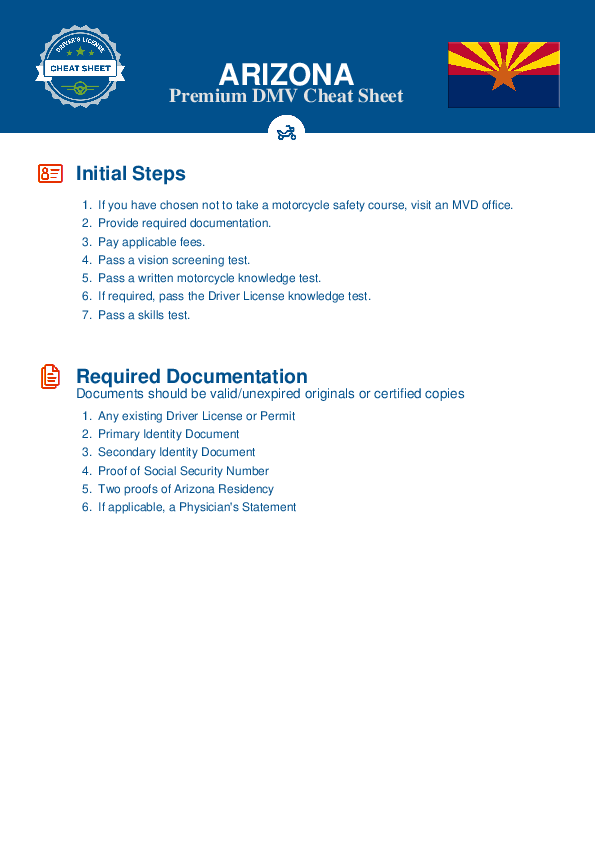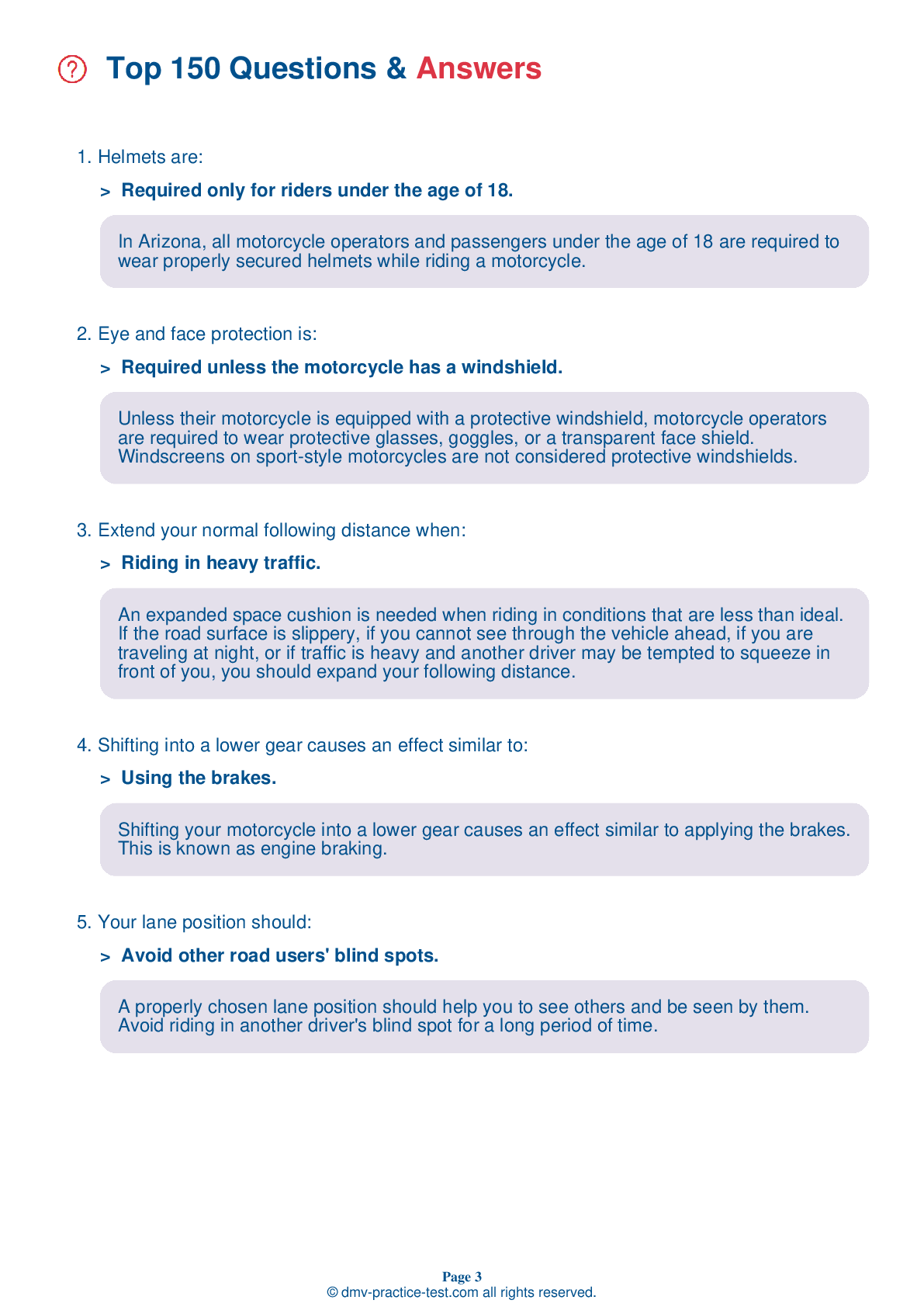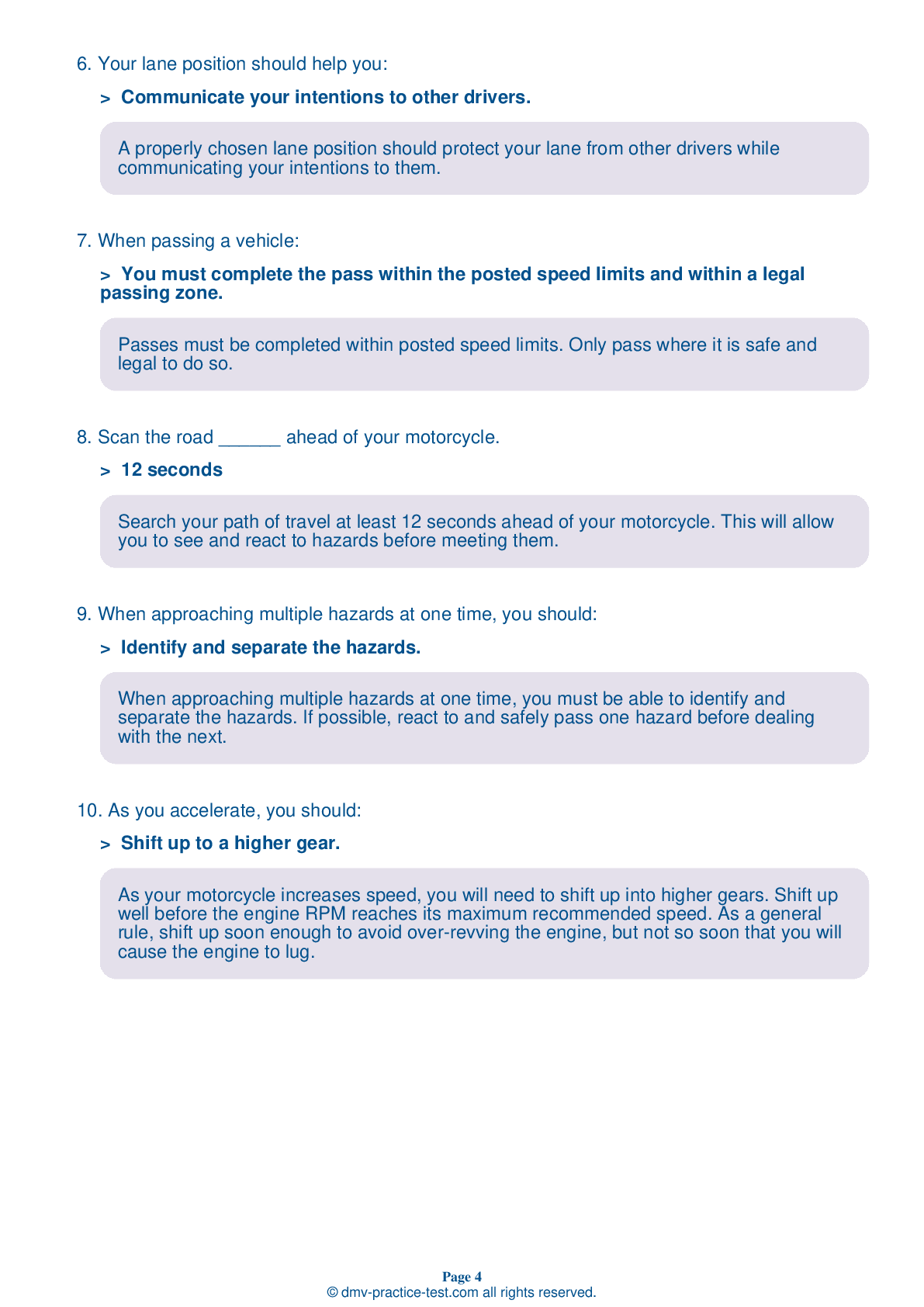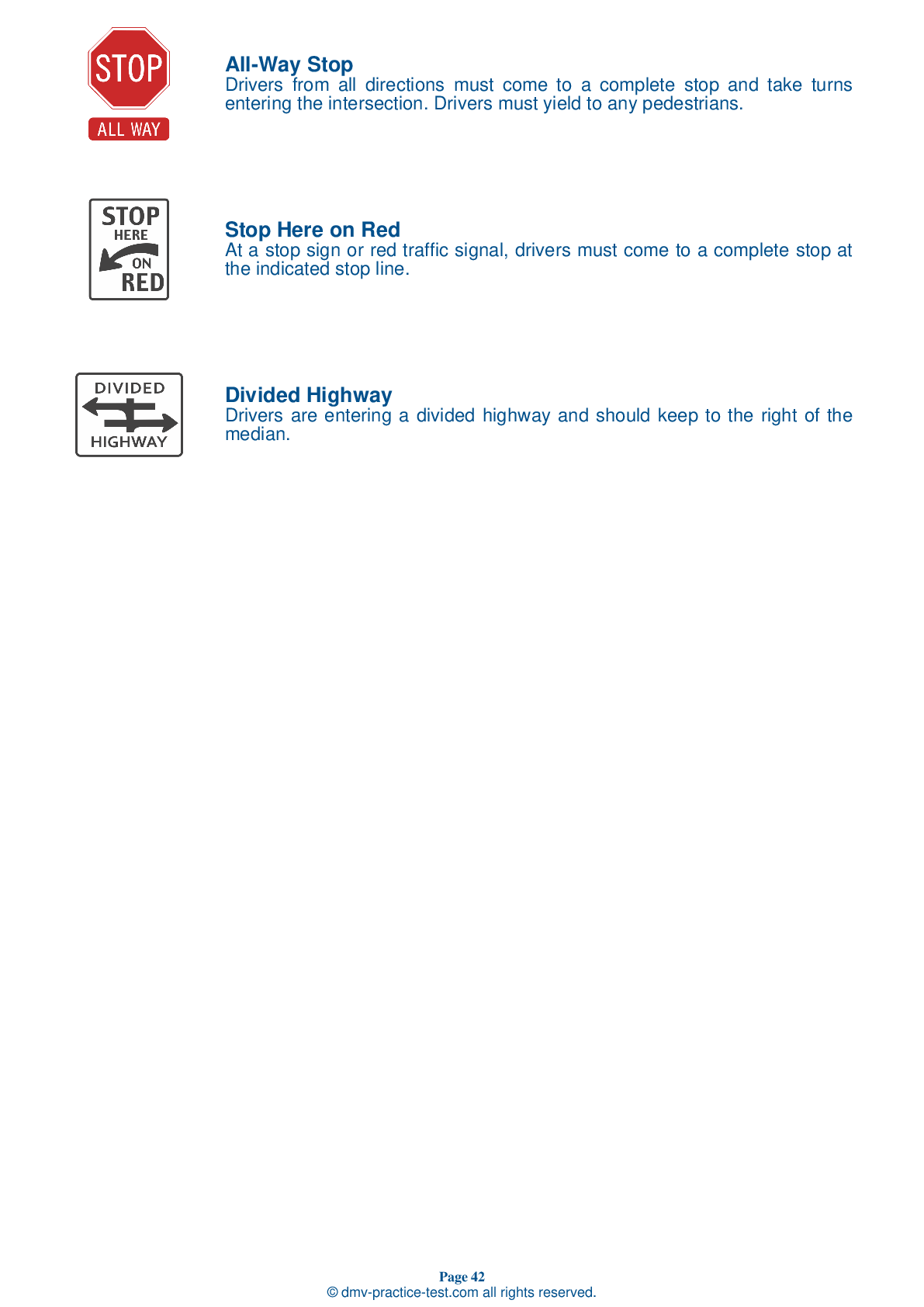DMV Permit Test #11
Motorcycle Test | License AZ 2025 | FREE Online Practice! #11
Take this FREE motorcycle test (license in AZ 2025) to check your knowledge of the road rules. To improve your results, download a motorcycle handbook online, study theory, and practice for free on our website. Still worried about how to get a motorcycle license in Arizona in 2025? Check our website for more sample tests, train as much as possible, and boost your grades!
30
25
16
1 . You should ride with your headlight on:
Under no circumstances.
Riders should use their headlight at all times. An activated headlight is the best way to help other road users see them. During the day, a motorcycle with its headlight on is twice as likely to be noticed as a motorcycle with no headlight.
2 . During the day, your headlight should:
Alternate between high beam and low beam settings.
Using your high beam headlight during the day increases the likelihood that other drivers will see you. Use your high beam headlight any time you are not riding behind or approaching other vehicles.
3 . When a lead rider is extending their left arm and pointing downward, it means:
Slow down.
Hand signals are an important part of communication when riding in groups. When a lead rider is extending their left arm and pointing downward, it means there is a hazard in the roadway on their left side.
4 . When slowing down or stopping, you must:
Never change gears.
Shift down through the gears as you slow down or stop. Stay in first gear while you are stopped to ensure that you can move quickly if you need to.
5 . Your lane position should:
Hide your intentions from other drivers.
A properly chosen lane position can optimize a number of safety factors. Your lane position should keep you out of other vehicles’ blind spots, increase your ability to see and be seen, help you avoid surface hazards, help you avoid wind blasts from other vehicles, and provide you with an escape route from any hazards that might arise. You should be positioned in a way that discourages other drivers from trying to share your lane.
6 . When passing a vehicle:
You must complete the pass within the posted speed limits and within a legal passing zone.
Passes must be completed within posted speed limits. Only pass where it is safe and legal to do so.
7 . Before every ride, you should:
Make sure you can see your helmet in your mirrors.
Perform safety checks before every motorcycle ride. Test your brake controls individually to make sure each one activates the brake lights.
8 . When riding a three-wheeled motorcycle, you should stay in:
Whichever portion of the lane you want.
Unlike when riding a two-wheeled motorcycle, you are limited in lane positioning when riding a three-wheeled motorcycle. Keep toward the center of the lane to be sure your wheels do not cross the painted lines into opposing traffic.
2025 Arizona | Frequently Asked Questions
To acquire a motorcycle driver's license in Arizona, you must first apply for a motorcycle instruction permit. This involves passing a written test. After practicing with the permit, you can apply for a motorcycle license, which requires passing a vision test and a skills test. Alternatively, you can complete an approved motorcycle driver education program to bypass the skills test.
In Arizona, the minimum age for obtaining a motorcycle license is 16 years old. However, if you are under 18, you must first hold a motorcycle instruction permit for at least six months and complete an approved motorcycle driver education program or have your parent or guardian certify that you have completed at least 30 hours of motorcycle riding practice.
Yes, you do need a dedicated license for motorcycle riding in Arizona. You can either add a motorcycle endorsement to your current driver's license or obtain a standalone motorcycle license. This requires passing both a written knowledge test and a skills test, or completing an approved motorcycle training course.
To apply for a motorcycle driver's license in Arizona, you'll need several documents: proof of identity (like a birth certificate or passport), Social Security number, and proof of Arizona residency. If you're under 18, you'll also need a parent or guardian's signature on the application. Remember to bring the completion card if you've completed a Motorcycle Safety Foundation course.
Yes, you will need to take a written exam for a motorcycle license in Arizona. The test covers subjects like motorcycle operation, traffic laws, road signage, safe riding practices, and handling emergency situations. However, if you complete a Motorcycle Safety Foundation course successfully, you can bypass this written test.
The motorcycle written test in Arizona covers a variety of topics related to motorcycle safety and operation. These include understanding traffic signs and signals, rules of the road, safe riding techniques, handling dangerous situations, and the effects of alcohol and drugs on motorcycle operation. It's all designed to ensure you can operate a motorcycle safely.
Yes, in Arizona, you can substitute the written test with a Motorcycle Safety Foundation (MSF) course. Upon successful completion of the MSF course, you'll receive a Motorcycle Safety Foundation card, which you can present at the MVD to waive the written and on-cycle skills test for your motorcycle endorsement.
Enrolling in a motorcycle training course in Arizona typically involves finding an approved training provider, checking the course schedule, and registering either online or by phone. Some providers may require payment at the time of registration. You'll need a valid driver's license or permit, and some courses may have age restrictions. Always confirm details with your chosen provider.
No, you don't have to own a motorcycle to take the license test in Arizona. You can use any legally registered and insured motorcycle for the test. If the motorcycle isn't registered in your name, you'll need signed permission from the owner. The motorcycle must also pass a pre-trip inspection.
Yes, you can use a friend's motorcycle for the driver's license evaluation in Arizona. However, the motorcycle must be legally registered, insured, and pass a pre-trip inspection. You must also have a signed permission from the owner if the motorcycle isn't registered in your name.
Yes, in Arizona, the motorcycle driving exam tests specific handling skills. These include the ability to start and stop, turn and swerve, and perform quick stops. It also tests your ability to negotiate intersections, maneuver around obstacles, and understand road signs. These skills are necessary for safe motorcycle operation in various traffic conditions.
Yes, Arizona imposes limitations on new motorcycle drivers. Those under 18 must hold an instruction permit for at least six months before obtaining a motorcycle license. They must also complete a driver education program or have a parent or guardian certify they've had at least 30 hours of supervised riding, including 10 hours of night riding.
Yes, your Arizona motorcycle license permits you to ride a motorcycle out of state. All U.S states recognize each other's driver's licenses under the Full Faith and Credit Clause of the U.S Constitution. However, you should abide by the motorcycle laws of the state you are visiting, as they may vary from Arizona's.
In Arizona, helmet laws are age-specific. If you are 17 years old or younger, you are legally required to wear a helmet when operating or riding on a motorcycle. However, for those who are 18 years or older, wearing a helmet is optional but highly recommended for safety purposes.
Yes, Arizona offers two types of motorcycle licenses. Class M is for all motorcycles, while a Class G graduated driver license or a Class D operator license with a motorcycle endorsement (J) is for motor-driven cycles with engine displacement of less than 100cc. The type of license needed depends on the type of motorcycle you plan to ride.
Yes, in Arizona, you can add supplementary endorsements to your motorcycle license. This allows you to operate additional types of vehicles. For example, a "J" endorsement allows you to legally operate a vehicle that requires a motorcycle license but has an enclosed passenger compartment. Each endorsement requires passing a separate written and/or skills test.
Yes, the motorcycle license test in Arizona can be taken in languages other than English. The Arizona Department of Transportation offers the exam in several languages, including Spanish. However, it's recommended to contact your local Motor Vehicle Department to confirm the availability of the test in your preferred language.
An effective strategy to prepare for the motorcycle license test is to thoroughly study the Arizona Motorcycle Operator Manual. It covers all the topics included in the test. You can also take online practice tests to familiarize yourself with the format and types of questions. Additionally, taking a motorcycle safety course can provide practical experience and knowledge.
Yes, in Arizona, the motorcycle written exam is available in multiple languages to accommodate non-English speakers. However, it's advisable to contact the Arizona Motor Vehicle Department ahead of time to confirm the availability of your preferred language. They can provide you with the necessary resources or schedule a translator if needed.
If you don't pass the motorcycle written test in Arizona, you're allowed to retake it. However, you must wait at least one day before making another attempt. It's recommended to study the Arizona Motorcycle Operator Manual thoroughly before retaking the test to increase your chances of passing.



